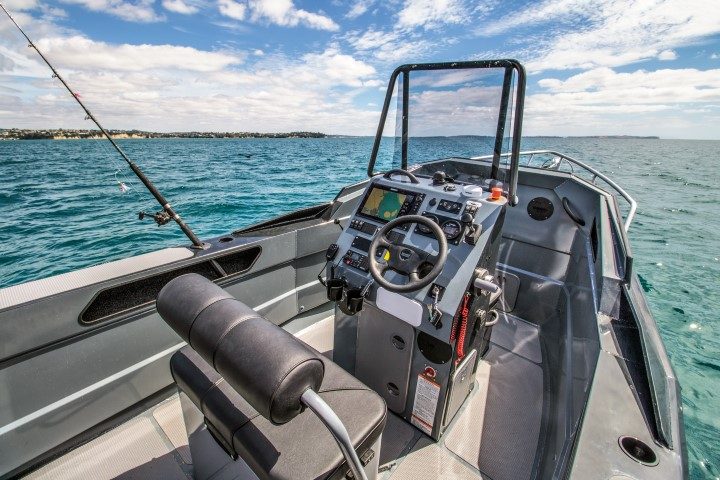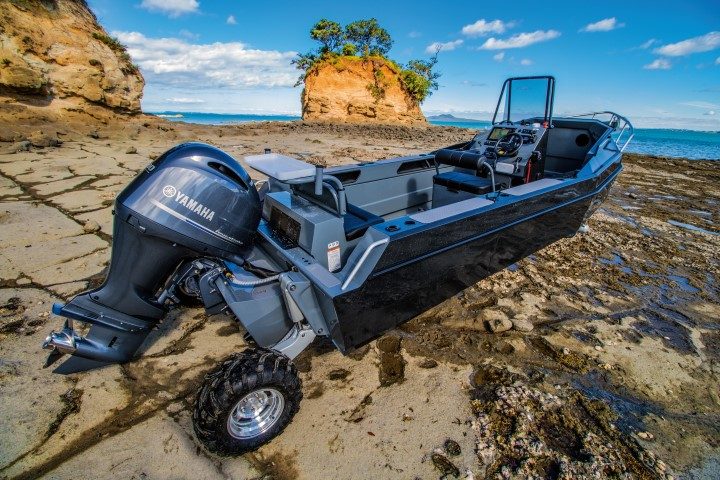‘Behemoth’ is a word which springs to mind or, perhaps more nautically, ‘leviathan’.

Sealegs continues to forge ahead, providing amphibious enablement systems (AES) to local and international boatbuilders, developing an upgraded AES for larger vessels and, most recently, announcing a new aluminium model.
The Sealegs 7.7m Sport D-Tube is the first boat in an expanded range of D-Tube models. Larger versions are in the pipeline.
Sealegs International already produces a 6.1m D-Tube model, an all-aluminium vessel that’s proven
popular with fishers and others who appreciate its rugged durability. The new 7.7 D-Tube is larger with more interior volume and a different hull profile. It should appeal to customers wanting a larger vessel with the seakeeping and performance that goes with a longer boat.
Manufactured in-house from marine grade aluminium, the boat utilises the same ultra-strong aluminium hull as Sealegs’ popular 7.7 RIB model, already engineered to accept a Sealegs AES, but replacing the inflatable fabric tubes are D-section aluminium floatation chambers. It fits inside a container for export.
The 7.7m Sport D-Tube reviewed here is the first out of the factory, customised for father-and-son owners who had specific requirements, so some of the features that will be standard on subsequent boats are missing, while others are unique to this vessel. But all D-Tube boats can be customised to some extent, says Sealegs’ Chief Operating Officer Damon Joliffe, depending on customer requirements.

This tall and rather imposing, fully-painted vessel weighs in at around 1700kg with a payload of 700kg. It’s fitted with Sealegs’ standard System 60 AES, which is rated to 2500kg.
Her owners have ordered a road trailer for easily transporting the vessel between a holiday beach house and home base, an increasingly common option, says Damon. Sealegs amphibians are simply driven onto purpose-built trailers before squatting down on their hydraulics so they can
be secured.
The new boat is a mix of familiar features from other Sealegs amphibians. As Damon describes it, it’s almost as though a 7F slept with a 6.1m Sport D-Tube, with a bit of 7.1 thrown into the mix. What’s immediately noticeable is the pronounced double chine, a raised foredeck with a spray dodger and a hint of sheer towards the bow, all of which promise a dry ride.
There’s a lot of freeboard, providing a sense of security insidethe boat, and the high sides make the 7.7 feel bigger than it really is. The six-chamber tubes offer quite a bit of useful storage in their upper sections too, which took some clever engineering to achieve without compromising buoyancy. There’s underfloor wet locker storage in the bows, plus storage in the console locker, glovebox and under the seats.

Neoprene non-slip panels have been glued to the cockpit sole and coamings. Made by 3M, they are soft underfoot, but durable, and easily replaced if damaged. The cockpit is self-draining through scuppers in the corners, an 1100gph bilge pump deals with any water finding its way into the hull and there’s a petrol fumes extractor in the bilge as well.
This boat is specified for a couple of keen fishers who wanted an uncluttered, workable cockpit that’s easy to fish from. They dispensed with Sealegs’ usual ski-hoop feature, leaving the transom unobstructed. A useful bait station with a couple of extra rod holders graces the transom and there are six through-coaming rod holders with adjacent sinker/cup holders.

The 22hp four-stroke Honda engine, and its associated blowers, air intake ducts, pipes and the three-way hydraulic pump for the vessel’s AWD system are integrated into the transom rather than positioned amidships under the helm seats as is the case for most Sealegs models. This frees up space in the cockpit and furnishes seating for two in the most comfortable place in the boat. There’s another seat in front of the console.
Access to the transom remains good either side of the vented machinery box. Extended run time, power steering and automatic braking are standard features. Automatic braking locks the wheels in the event of a loss of hydraulic pressure which includes when the Honda engine isn’t operating, or
when the forward-reverse lever is in the neutral position.
This boat’s owners initially wanted the wider console from the 7.7m RIB, which would have made it very tight accessing the bow, but the team at Sealegs convinced them to opt for the narrower RS console, which has a more robust screen and is much easier to walk around.
The screen folds down for garaging. There are handholds fitted to the console and forward in the bows, but fewer than usual at the owners’ request. Batteries are housed in the centre console – a second battery is an option.
The vessel’s customer-specified electronics include a Simrad NSSII 12-inch MFD and Simrad VHF. There’s no stereo/entertainment system at the customers’ request – speaker cut-outs are plugged with plastic inserts.

The console’s raked dashboard is well laid out, though quite busy. In addition to the normal gauges and controls for the Yamaha outboard, it also accommodates Sealegs’ AES gauges, switches and hydraulic controls.
The outboard’s throttle lever is on the starboard side of the console, which is fine, but when levers are mounted this way the outboard’s trim control is on the outside of the handle, making it a bit fiddly to use. The control lever for the AES hydraulics is on the dashboard just above the wheel, with the forward and reverse lever on the side of the console, to port.
I always get a buzz as a Sealegs drives into the water under its own power. The 7.7m Sport D-Tube is no different to any other Sealegs in this respect, though with its all-wheel-drive system, it can tackle more challenging terrain than two-wheel-drive models.
Individual hydraulic motors in each wheel provide on-land motivation and a ‘diff lock’ option is available for even better traction in soft sand or mud. Maximum speed on land is 7.5kph and continuous run time is 30 minutes.
SEA TIME
On the water a 200hp Yamaha four-stroke provides the motive power. This is the four-cylinder model but the 7.7m Sport D-Tube can also accept the slightly heavier, torquier six-cylinder Yamaha
200hp, or a pair of 90hp outboards. With the inline four-cylinder the 7.7 reaches a top speed of 42 knots, cruising comfortably at 30 knots. There’s a 180-litre underfloor tank serving fuel to both the
Honda stationary engine and the outboard.
The helm seat with its reversible backrest offers good support when standing to drive, which I suspect is how most people will operate this vessel. There are no footrests when sitting down to drive, but forward vision is good, standing or sitting. Two people are reasonably sheltered behind the console but a bimini and clears are an option for additional weather protection.
As I suspected upon seeing the boat on the beach for the first time, the 7.7m Sport D-Tube is a dry runner. The high bow, chine flats and chest-high dodger deflect spray and the bow also provides shelter from the wind.
For an alloy-hulled vessel, the 7.7m Sport D-tube is smooth and quiet and we had enough chop to
determine the boat rides softly and handles well. It feels quite sporty, nimble even, despite carrying the weight of the Sealegs AES and all the extra underdeck structure amphibious operation demands. Like other boats in the Sealegs range, the export-ready 7.7 D-Tube is built to meet CE (European Union), US and Australian Coastguard standards.
Walkaround access to the bows is good. An inspection hatch in the foredeck opens onto the anchor locker, which is deep with plenty of fall. A Maxwell rope-chain capstan takes care of anchor duties, raising and lowering a Sarca anchor that’s fixed on the extra-long bowsprit/fairlead, necessary to clear the front wheel assembly. The unpainted bowrail is an optional extra.
Transitioning between on-water and on-land operation is straight forward and will be familiar to anyone who’s previously owned a Sealegs amphibian. The technology has been continuously refined over more than 10 years and 1,100 vessels – so operating the 7.7m Sport D-Tube is easy. Provided the
procedure for entering and exiting the water is followed in the correct order, little can go wrong.
The biggest mistake inexperienced operators make, says Damon, is killing outboard power before the wheels are driving the vessel up the beach, potentially leaving it at the mercy of wind and waves. Similarly, on entering the water the outboard should already be providing thrust before the wheels completely clear the sea floor.

The Honda engine’s throttle can be set at moderate revolutions and then forgotten, the hydraulic controls are easy enough to use. Seastar hydraulic power steering works on land and sea and there’s a large, bright red emergency/safety stop button that will mechanically lock the wheels should anything go wrong during terrestrial operation.
The Sealegs 7.7m Sport D-Tube provides an interesting alternative to a standard fabric-tubed Sealegs models. Like its smaller sibling, the 6.1m Sport D-Tube, the 7.7 is an open, centre-console design, so it doesn’t compete directly with AESequipped D-tube hardtop cabin models from Stabicraft, but it’s
ruggedness and enhanced utility could further widen Sealegs’ appeal, attracting fishers and others wanting a more knockabout amphibious vessel.
‘Behemoth’ is a word which springs to mind or, perhaps more nautically, ‘leviathan’.
White Pointer has earned the respect of discerning customers in New Zealand and Australia, attracting a loyal and ever growing following for its high-quality, rugged and totally dependable aluminium trailer boats.
The hardtop SP635 shares the same underpinnings as the popular SF 635 which was a completely new model back in 2020.
The pride and joy of a multi-generational family, Bliss resides on a pier that’s home to a couple of other Elite motor launches – Sandspit Marina is a hot-spot for the Bill Upfold-designed vessels, with several calling this small marina home.